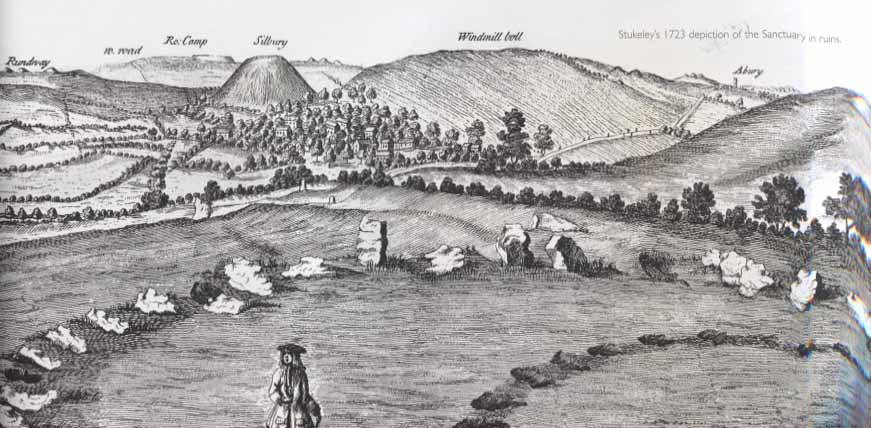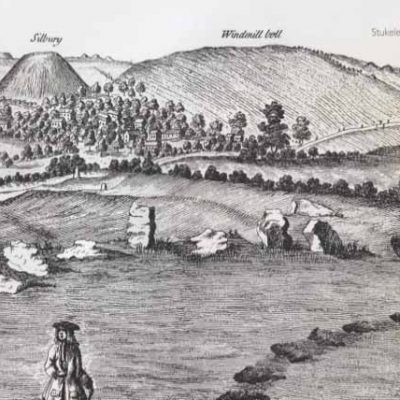

Steve Marshall lives close to Avebury and has spent many years researching and exploring the area. He realises that many people only go to the Stone Circle and ignore the other monuments in the landscape. Avebury was restored by Alexander Keiller (marmalade magnate) in the 1930s. He re-erected many fallen stones and spent millions of pounds on the site. The onset of World War II stopped his work.
The Henge 2630-2460BC
The bank and ditch were erected. The henge has a diameter of ¼ mile. There are gaps in the original and researchers think of it in four quadrants – NW/NE/SE/SW. They are very impressive earthworks.
Keiller used a bulldozer to clear the ditches of the henge; he also used dynamite. The tops of the banks are uneven. There is a berm (level space/platform) in the NE quadrant and the water table is 2m higher than today. There would have been water in the bottom of the ditches at some times.
Sarsens: Are they male and female? It is difficult to compare them all. Many had been toppled and buried in the Medieval period. One of the largest stones weighs 80 tons. The NE quadrant is not restored and the Cove is here. It consists of 3 stones and the largest weighs 100 tons. This is the biggest stone at Avebury and 3m of it is below ground. Some stones are still buried and will stay that way.
Obilisk: Stukeley recorded it – 6.4m long x 2.7m diam. It would have been very impressive within its circle of stones.
In the SW quadrant Keiller found only one stone standing; he restored this circle and it is almost complete. Some stones are not in alignment and are slightly skewed.
In the Medieval period, a lot of sarsen stone was fired in pits, with water being thrown over the hot stones to crack them. Much of this stone went into the walls, paths and pavements of the Avebury houses. There are differences in the geology of the sarsens – many large stones are pink.
West Kennet Avenue 2600-2300BC
Keiller restored half a mile of the Avenue and found buried stones. The Avenue’s direction changes several times and it is suggested that the straight sections have astronomical significance. In the northernmost section from pairs 6-15, the winter solstice sun rises midway between the two rows of stones.
Beckhampton Avenue 2250-2000BC.
Stuckley suggested there was a second avenue, but it was regarded as fantasy. In 2000, Josh Pollard and Mark Gillings found through excavation and geophysical survey, that there was a second Avenue. The stones Adam and Eve (the Longstones) are at the end of the Beckhampton Avenue.
Water
Water is very important to henge monuments and to the Neolithic. Just outside the Avebury henge is the confluence of two rivers. They are seasonal. There are many springs in the area including Swallowhead Springs, which is now a shrine. Water from these springs flow into the Kennet. The temperature of the springs is a constant 10oC, so they can be seen during a snow fall, or frost. Around the River Oslip are 8 acres of springs. This is a vast amount of water in the area; the Oslip Springs are near Windmill Hill.
Windmill Hill 3670-3620BC
Later Bronze Age barrows are built on the Windmill Hill causewayed enclosure. It consists of three concentric rings of interrupted banks and ditches. It is the only hill in the area. In 1927 Keiller bought the land. Neolithic builders built the two outer rings, then went off to construct the West Kennet long barrow. They returned to build the inner ring. The outer ring is the same diameter as the Avebury Circle.
West Kennet long barrow 3670-3635BC
It is a long mound 104m long, flanked by parallel ditches. It contains a stone chamber with side chambers off it. Steve Marshall has done a lot of work on the acoustics of the tomb. In the 1950s the dry stone walling was replaced when the tomb was reconstructed. It is believed to have been used for one generation. Each stone has been photographed and can be seen in Exploring Avebury. The Essential Guide.
Stone 18 is a polissoir (polished stone) that was used for polishing stone axes outside for a long time before being brought into the passage of the tomb. Others include stones 21 and 24. Stuart Piggot (who excavated the monument) found two more that were covered up inside.
The Sanctuary
In 1724 William Stukeley realised that farmers were destroying it. There had been an earlier timber circle on the site before the stone one was erected. A larger outer circle (40m in diameter) encloses the monument. There probably is an astronomical alignment. We don’t know if the upright timbers had lintels.
Silbury Hill 2450-2350BC
Silbury Hill consists of 200 layers of chalk rubble that naturally lies at an angle of repose at 30o. This makes the shape of the hill. Was Silbury originally scoured and whitened, like the hill figures? In high rainfall a ditch surrounds part of it and fills with water and there are springs at 10oC around the western ditch.
Silbury was built on the confluence of two rivers (an east/south confluence). If snow fell, the springs would melt the snow around Silbury. The grass’s roots had been warmed by the spring water and would carry on growing throughout the winter, therefore giving very green, early spring grass.
Palisaded Enclosures 2500-2400BC
There is nothing to see on the ground today. One of the enclosures straddles the River Kennet and is huge (the same size as the Avebury henge). There is a water connection and thousands of pigs were slaughtered here as part of feasting in the Neolithic. There was a solid wall of timber posts and pig bones in the packing material. We can compare the site to Durrington Walls, but the site does remain a mystery. Little excavation has been carried out. The lines of the palisades go for half a mile across the countryside and may contain another timber circle.
This was a fascinating and enlightening talk. For more information and details go to Steve Marshall’s webside: www.exploringavebury.com
The book contains beautiful photographs and much more information. £14.99.
Marshall, S., 2016. Exploring Avebury. The essential guide. The History Press.
ISBN 978 0 75096766 2

Stukeley’s 1723 depiction of The
Sanctuary in ruins (after Marshall 2016)
